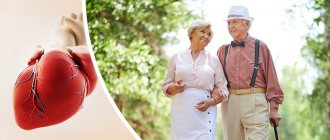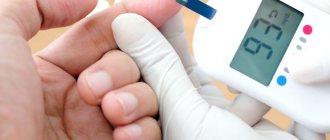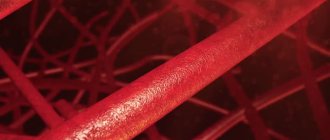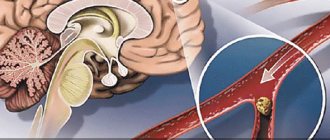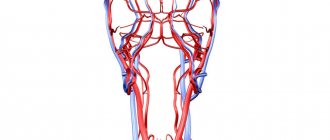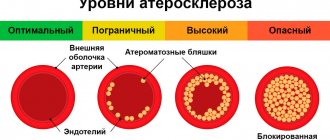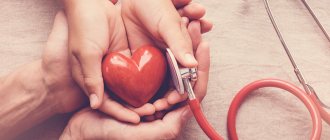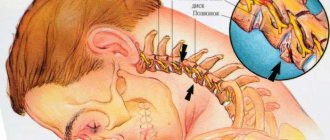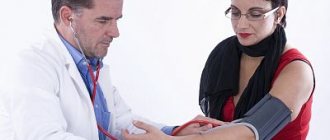"Nursing process in hypertension"
Article outline:
- Definition of hypertension.
- Etiology and factors contributing to the development of hypertension.
- Features of the clinical course of hypertension.
- Complications of hypertension.
- Diagnosis of the disease.
- Principles of treatment and care for patients with hypertension.
Hypertension is a disease whose leading symptom is a persistent increase in blood pressure caused by a neuro-functional disorder of vascular tone.
Causes of essential hypertension
- Chronic overstrain of the central nervous system
- Nervous and mental trauma
- Hereditary predisposition
Contributing Factors
- Dysfunction of the endocrine glands (hypothalamus, pituitary gland)
- Smoking
- Eating a lot of salt
- Features of the profession that require great responsibility
- Insufficient sleep
- Alcohol abuse
- Physical inactivity
- Age – men over 55 years old, women over 65 years old
- Obesity
- Diabetes
The clinic distinguishes 3 stages of the disease:
Stage 1 – initial Stage 2 – 2A – labile
2B – stable
Stage 3 – sclerotic
Complications of hypertension
- Cerebrovascular accident (stroke)
- Acute and chronic heart failure
- Myocardial infarction
- Kidney failure
- Heart rhythm disturbances
- Retinal vascular damage
- Hypertensive crisis.
A hypertensive crisis is a sudden increase in blood pressure, accompanied by disorders of the autonomic nervous system, an increase in all symptoms of the disease, a disorder of the coronary, cerebral, and renal circulation and an increase in blood pressure to individual high numbers.
Basic principles of correct blood pressure measurement
The patient should sit upright, the forearm should lie horizontally, the shoulder should be at an obtuse angle to both the body and the forearm
The measurement should be carried out no earlier than 2 minutes after the patient has taken the indicated position and relaxed
All measurements must be taken on the same arm as indicated in the patient's medical record.
The width of the cuff should be approximately 1/3 of the shoulder length
The lower end of the cuff should be 2.5 cm from the elbow cavity
Measurement should be carried out in a quiet room
The air in the cuff is inflated by approximately 20 mmHg. Art. exceeding systolic pressure; the pressure in the cuff decreases at a rate of 2–4 mmHg. Art. per second
Principles of treatment of hypertension
1.Non-pharmacological methods
- Quitting smoking or reducing the number of cigarettes smoked
- Weight loss
- Reducing salt intake to 5 – 6 g/day.
- Limit fluid intake to 1.2 l/day.
- Increasing potassium intake to 120 mg/day.
- Increasing calcium intake to 800 – 1200 mg/day.
- Increased magnesium intake
- Increased consumption of plant fiber up to 24 mg/day.
- Increased intake of complete protein
- Vitamin C at a dose of 500 mg/day.
- Reducing caffeine intake
- Increasing physical activity
- Creating optimal working and living conditions
- Normalization of sleep
- Phytotherapy
- Pharmacological methods
- Diuretics (furosemide, spironaloctone, veroshpiron, indapamine)
- B – blockers (atenolol, tenormin, anaprilin)
- Calcium antagonists (nifedipine, verapamil)
- ACE inhibitors (captopril, enalapril, lisinopril)
Nursing process in hypertension
Content
Introduction…………………………………………………………………………………3
1. Etiology……………………………………………………………………………….4
2. Clinic………………………………………………………………………………….5
3. Diagnostics………………………………………………………………………………..7
4. Treatment………………………………………………………………………………….8
5. Nursing process for hypertension……………………..9
Conclusion……………………………………………………………………………….15
Literature………………………………………………………………………………..16
Introduction
Arterial hypertension is an increase in blood pressure in the arteries as a result of increased heart function or increased peripheral resistance, or a combination of these factors. There are primary (essential) and secondary arterial hypertension.
Hypertension, or essential hypertension, is an increase in blood pressure not associated with organic damage to the organs and systems that regulate it. The development of hypertension is based on a violation of the complex mechanism that regulates blood pressure under physiological conditions.
According to a survey of a representative sample (1993), the age-standardized prevalence of hypertension (>140/90 mm Hg) in Russia is 39.2% among men and 41.1% among women. Women are better informed about the presence of the disease than men (58.9% versus 37.1%), are treated more often (46.7% versus 21.6%), including effectively (17.5% versus 5. 7%). In men and women, there is a clear increase in hypertension with age. Before 40 years of age, hypertension is more often observed in men, after 50 years - in women.
The development of hypertension can be divided into three parts:
central - a violation of the relationship between the processes of excitation and inhibition of the central nervous system;
increased production of pressor substances (norepinephrine, aldosterone, renin, angiotensin) and a decrease in depressor effects;
tonic contraction of arteries with a tendency to spasm and organ ischemia.
Etiology
Hereditary burden is the most proven risk factor and is well identified in relatives of the patient of close kinship (the presence of HD in mothers of patients is of particular importance). We are talking, in particular, about the polymorphism of the ACE gene, as well as the pathology of cell membranes. This factor does not necessarily lead to headache. Apparently, genetic predisposition is realized through the influence of external factors.
People with excess body weight have higher blood pressure. Epidemiological studies have convincingly shown a direct correlation between body weight and blood pressure. With excess body weight, the risk of developing hypertension increases 2-6 times (Quetelet index, which is the ratio of body weight to height, exceeds 25; waist circumference >85 cm in women and >98 cm in men). The factor of excess body weight is associated with a more frequent development of hypertension in industrialized countries.
Metabolic syndrome (syndrome X), characterized by a special type of obesity (android), insulin resistance, hyperinsulinemia, and lipid metabolism disorders (low levels of high-density lipoproteins - HDL - are positively correlated with increased blood pressure).
Alcohol consumption. SBP and DBP in persons who consume alcohol daily are 6.6 and 4.7 mmHg, respectively. higher than in people who drink alcohol only once a week.
Salt consumption. Many experimental, clinical and epidemiological studies have shown a connection between high blood pressure and daily consumption of table salt.
Physical activity. People living a sedentary lifestyle are 20-50% more likely to develop hypertension than physically active people.
Psychosocial stress. It has been established that acute stress load leads to an increase in blood pressure. It is assumed that long-term chronic stress also leads to the development of hypertension. The patient’s personality traits are probably also of great importance.
Clinic
The central symptom of hypertension is an increase in blood pressure, from 140/90 mm Hg. Art. and higher.
Main complaints: headaches, dizziness, blurred vision, pain in the heart, palpitations. Patients may have no complaints. The disease is characterized by an undulating course, when periods of deterioration are replaced by periods of relative well-being.
In the stage of functional disorders (stage I) there are complaints of headaches (usually at the end of the day), sometimes dizziness, and poor sleep. Blood pressure increases inconsistently, usually due to anxiety or fatigue (140-160/905-100 mm Hg).
In the second stage.
Complaints of constant headaches localized in the occipital region. Patients have poor sleep and dizziness. Blood pressure is persistently elevated. Attacks of pain in the heart appear.
In stage 2 hypertension, the ECG shows signs of left ventricular hypertrophy and myocardial malnutrition.
In stage three hypertension, various organs are affected, primarily the brain, heart and kidneys. Blood pressure is persistently elevated (more than 200/110 mm Hg). Complications develop more often.
Hypertensive crisis
- a sudden increase in blood pressure, accompanied by disorders of the autonomic nervous system, increased disorders of the cerebral, coronary, and renal circulation and an increase in blood pressure to individually high numbers.
There are crises of types I and II.
Type I crisis occurs in stage I headache and is accompanied by neurovegetative symptoms.
Type II crisis occurs in stages II and III of headache.
Symptoms of a crisis:
severe headache, transient visual impairment, hearing impairment (stupefaction), heart pain, confusion, nausea, vomiting.
The crisis is complicated by myocardial infarction and stroke. Factors provoking the development of crises: psycho-emotional stress, physical activity, sudden withdrawal of antihypertensive drugs, use of contraceptives, hypoglycemia, menopause, etc.
The benign variant of the development of hypertension is characterized by slow progression, changes in organs are at the stage of stabilization of blood pressure. The treatment is effective. Complications develop only in the later stages. For definitions of risk levels, see the table.
The malignant variant of hypertension is characterized by a rapid course, high blood pressure, especially diastolic, rapid development of renal failure and brain disorders. Changes in the fundus arteries with foci of necrosis around the optic nerve nipple and blindness appear quite early. The malignant form of hypertension can be fatal if left untreated.
Diagnostics
Diagnosis of hypertension and examination of patients with hypertension is carried out in strict sequence, meeting certain objectives:
— determination of the stability of the increase in blood pressure and its degree;
- exclusion of symptomatic hypertension or identification of its form;
— identifying the presence of other risk factors for cardiovascular diseases and clinical conditions that may affect prognosis and treatment, as well as classifying the patient to a particular risk group;
— determination of the presence of lesions of “target organs” and assessment of their severity.
According to the 1999 WHO-ITF international criteria, hypertension is defined as a condition in which blood pressure is 140 mmHg. Art. or higher and/or ADD - 90 mm. rt. Art. or higher in individuals not receiving antihypertensive therapy.
Headache is divided into primary, when headache and associated symptoms form the core of the clinical picture and are combined into an independent nosological form (migraine, tension headache, cluster headache), and secondary, when it becomes a consequence of obvious or masked pathological processes.
Among primary headaches, the most common forms are tension-type headache (TTH) and migraine (M).
In a patient with newly diagnosed hypertension, a careful history must be taken, which should include: - the duration of hypertension and levels of elevated blood pressure in the history, as well as the results of previously used antihypertensive treatment, a history of hypertensive crises.
Additional examination:
OAK—increase in red blood cells, hemoglobin. BAC—hyperlipidemia (due to atherosclerosis). OAM—proteinuria, cylindruria (with chronic renal failure). Zimnitsky test - isohyposthenuria (with chronic renal failure). ECG - signs of left ventricular hypertrophy. Ultrasound of the heart - enlargement of the wall of the left ventricle. Examination of the fundus - narrowing of the arteries, dilatation of the veins, hemorrhages, swelling of the optic nerve nipple.
Treatment
Treatment of stage I headache is usually carried out using non-drug methods, which can be used at any stage of the disease. A hyposodium diet is used, body weight is normalized (fasting diets), limiting alcohol intake, quitting smoking, constant physical activity, acupuncture, rational psychotherapy, acupuncture, physiotherapeutic treatment, herbal medicine.
If there is no effect from non-drug treatment within 6 months, drug treatment is used, which is prescribed in stages (starting with one drug, and if ineffective, a combination of drugs).
In patients with stages I and II, the leading role in treatment belongs to systematic drug therapy, which should be comprehensive. At the same time, it is necessary to systematically carry out preventive measures, among which physical education occupied a significant place.
Long-term antihypertensive therapy with individual maintenance doses is required. In elderly patients, blood pressure decreases gradually, since a rapid decrease worsens cerebral and coronary circulation. Blood pressure should be reduced to 140/90 mmHg. or to values lower than the original ones by 15%. Treatment should not be abruptly stopped; treatment should begin with known medications.
Of the many groups of antihypertensive drugs, 4 groups have received practical use: β-blockers (propranolol, atenolol), diuretics (hypothiazide, indapamide, uregit, veroshpiron, arifon), calcium antagonists (nifedipine, adalat, verapamil, amlodipine) ACE inhibitors (captopril , enalapril, sandopril, etc.).
Nursing process in hypertension
Lifestyle changes are recommended for all patients, including those receiving drug therapy, especially in the presence of certain risk factors. They allow:
lower blood pressure; reduce the need for antihypertensive drugs and maximize their effectiveness; favorably influence other existing risk factors; carry out primary prevention of hypertension and reduce the risk of concomitant cardiovascular disorders at the population level.
Non-drug methods include:
- to give up smoking; — reduction and/or normalization of body weight (achieving a BMI < 25 kg/m2); - reducing the consumption of alcoholic beverages to less than 30 g of alcohol per day in men and less than 20 g per day in women; - increase in physical activity (regular aerobic (dynamic) physical activity for 30-40 minutes at least 4 times a week); — reducing the consumption of table salt to 5 g/day;
- a comprehensive change in diet (increasing the consumption of plant foods, reducing the consumption of saturated fats, increasing the diet of potassium, calcium contained in vegetables, fruits, grains, and magnesium contained in dairy products).
The target blood pressure level is a blood pressure level of less than 140 and 90 mm Hg. In patients with diabetes, it is necessary to reduce blood pressure below 130/85 mm Hg. Art., with chronic renal failure with proteinuria more than 1 g/day below 125/75 mm Hg. Achievement of target blood pressure should be gradual and well tolerated by the patient. The higher the absolute risk, the more important it is to achieve the target blood pressure level. With regard to concomitant hypertension and other associated risk factors, it is also recommended to achieve their effective control, and, if possible, normalize the corresponding indicators (Table 5. Target values of risk factors).
Achieving and maintaining target blood pressure levels requires long-term monitoring with monitoring of compliance with recommendations for lifestyle changes, regularity of antihypertensive therapy and its correction depending on the effectiveness and tolerability of treatment. During dynamic observation, it is crucial to achieve individual contact between the patient and the nurse, and a patient education system that increases the patient’s sensitivity to treatment.
In a hospital setting, the entire rehabilitation process is based on three motor modes: bed: strict, extended; ward (semi-bed); free.
During extended bed rest, the following tasks are solved: improving the neuropsychic status of the patient; gradual increase in the body’s adaptation to physical activity; decreased vascular tone; activation of the function of the cardiovascular system by training intra- and extracardiac circulatory factors.
At the stage of ward (semi-bed) rest, the following tasks are solved: eliminating the patient’s mental depression; improving adaptation of the cardiovascular system to increasing loads through strictly dosed training; improvement of peripheral blood circulation, elimination of congestion; training in proper breathing and mental self-regulation.
During the free regime, the tasks of improving the functional state of the central nervous system and its regulatory mechanisms are solved; increasing the overall tone of the body, the adaptability of the cardiovascular and respiratory systems and the whole body to various physical activities; strengthening the myocardium; improving metabolic processes in the body.
This motor mode in a hospital setting is characterized by the greatest motor activity. The patient is allowed to walk freely around the department; it is recommended to walk up the stairs (within three floors) with pauses for rest and breathing exercises
In hypertensive crisis
Lasix IV, nitroglycerin, clonidine or Corinfar, nifedipine - 1 table are used. under the tongue. If there is no effect - intravenous aminophylline, intravenous labetolol. Parenteral treatment is prescribed by a doctor.
It should be remembered that blood pressure must be reduced slowly, over 1 hour; with a rapid decrease, acute cardiovascular failure can develop, especially in the elderly. Therefore, after 60 years, antihypertensive drugs are administered only intramuscularly.
Treatment of hypertension is carried out for a long time and antihypertensive drugs are discontinued only when blood pressure stabilizes to the desired level over time (the doctor decides to cancel).
Stage I – nursing examination based on objective and subjective complaints
sick
Stage II Stage III Stage IV Stage V
| Patient problems | Goals | Nursing interventions | Evaluating the effectiveness joint venture (produced upon expiration of the delivery period) no purpose | ||
| k/s | d/s | plan | motivation | ||
| Main: - increased blood pressure | Achieve a gradual decrease in blood pressure by the end of the first day | Achieve stabilization of blood pressure indicators by day 10 (at discharge) | 1. Ensure physical and psychological rest 2. Place the patient or transfer him to a horizontal position with the head end raised 3. Provide access to fresh air 4. Place mustard plaster on the area. back of the head and calf muscles 5. Monitor the patient’s condition, measure blood pressure every 30 minutes until blood pressure normalizes 6. Follow all doctor’s orders: monitor regular intake of antihypertensive drugs 7. Train the patient in measuring blood pressure | For the effectiveness of treatment In order to reduce blood flow to the goal. brain and heart For enriched. air with oxygen To reduce blood pressure For timely. providing emergency assistance in case of emergency. complications | By the end of the first day, blood pressure was reduced - the goal was achieved. By the 10th day, blood pressure remained at a stable level - the goal was achieved. |
| - headaches, dizziness, tinnitus | The patient will note a decrease in goals. pain and dizziness by the end of the 3rd day | The patient will not complain about the goal. pain and dizziness - dizziness at the time of discharge | 1. Ensure physical and mental rest 2. Ensure medication intake. Medicines prescribed by a doctor. 3. If dizziness occurs, accompany the patient. 4. Ensure frequent ventilation of the rooms. | By day 3, the patient has no headaches - the goal has been achieved. At the time of discharge, the patient does not complain of headaches - the goal has been achieved. | |
| Comorbidities: sleep disturbance | Within 7 days the patient will be able to fall asleep and sleep without awakening for 4-6 hours, if necessary with the help of sleeping pills | By the time of discharge from the hospital, the patient will be able to sleep from 6 to 7 hours continuously without taking sleeping pills | 1. Observe the patient’s sleep and assess sleep disturbances. 2. Distract the patient from sleep during the day (which promotes night sleep) 3. Ensure that all types of food and drinks containing caffeine are excluded from the patient’s diet, including tea and coffee. 4. Take measures to help the patient fall asleep, e.g.: rubbing the back, warm baths, airing the room before bed, warm non-stimulating drinks (milk), quiet music, relaxation exercises. 5. Set a certain time for going to bed and do not violate this schedule. 6. Assure the patient that if he needs anything, he will get the help he needs. 7. As prescribed by the doctor, give the patient sleeping pills | For the first 5 days the patient slept with the help of sleeping pills, from the 6th day he began to fall asleep without them - the goal was achieved. | |
| - vomit | Reduce the severity of vomiting by the end of 3 days | Vomiting will not bother the patient | 1. Provide the patient with everything necessary (basin, tray) for vomit, towel, mouthwash, if necessary 2. Avoid dehydration (give drink) 3. Create physical and mental peace, eliminate bright light, noise. 4. Give antiemetics as prescribed by the doctor. | On the 2nd day the patient no longer complains of vomiting - the goal has been achieved | |
| - irritability, anxiety | Reduce the patient's irritability and anxiety within 6 days | The patient will not be irritable upon discharge | 1. Create a calm environment. 2. Talk with the patient more often on various topics. 3. Instill confidence in a favorable outcome of the disease 4. Ensure the use of sedatives (such as valerian, motherwort) as prescribed by the doctor 5. Teach the patient relaxation methods. | By day 6, the patient became less irritable, the anxious state does not bother the patient - the goal has been achieved. | |
| Potential - the possibility of developing complications; — ineffectiveness of taking antihypertensive drugs. | Prevent the development of complications and progression of the disease | 1. Conduct conversations: A) about the importance of observing work, rest, diet - with limited salt and liquid. B) about the effect of smoking and drinking alcohol on increasing blood pressure C) about the importance of systematically taking antihypertensive drugs and periodically visiting a doctor. | |||
Conclusion
Hypertension is a chronic disease that affects various systems of the body, characterized by an increase in blood pressure above normal, the most common disease of the cardiovascular system.
It has been established that those suffering from hypertension account for 15 - 20% of the adult population according to various epidemiological studies. HD quite often leads to disability and death. The underlying cause of the disease is arterial hypertension.
Arterial hypertension is one of the main risk factors for the development of coronary artery disease, cerebral stroke and other diseases.
Primary prevention of hypertension is the prevention of etiological risk factors.
Secondary prevention is medical examination of patients with hypertension. Patients are examined and examined at least once a year.
The main goal of treating a patient with hypertension is to achieve the maximum degree of reduction in the overall risk of cardiovascular morbidity and mortality. This involves addressing all identified reversible risk factors, such as smoking, high cholesterol and diabetes, appropriate treatment of associated diseases, as well as correction of high blood pressure itself.
The target blood pressure level is a blood pressure level of less than 140 and 90 mm Hg. In patients with diabetes, it is necessary to reduce blood pressure below 130/85 mm Hg. Art., with chronic renal failure with proteinuria more than 1 g/day below 125/75 mm Hg. Achievement of target blood pressure should be gradual and well tolerated by the patient.
Literature
1. Gogin E.E. “Hypertension” - M, 1997 – 62 p.
2. Roytberg G. E. Strutynsky A. V. Internal diseases. Cardiovascular system, M, 2002 – 123 p.
3. Smoleva E.V. Nursing in therapy. – Rostov n/a: Phoenix, 2007 – 169 p.
4. Tulyankin V.F. Tulyankina T.I. Home Doctor. JSC "Paritet", 2002-248p.
Nursing interventions in hypertensive crisis
- Call a doctor through an intermediary
- Position the patient in bed with the head of the bed elevated
- Unbutton tight clothing
- Provide access to fresh air
- Measure blood pressure, pulse and respiratory rate
- Place mustard plasters on the back of the head and calf muscles, leeches on the mastoid processes, apply hot foot baths
- Prepare for the doctor’s arrival: syringes, drip system, antihypertensive drugs (25% magnesium sulfate solution, 1% dibazole solution, 2% papaverine hydrochloride solution, 0.01% clofelline solution, 5% pentamine), 0.9% saline solution, sedatives (Relanium solution 2.0), diuretics (Lasix solution 2.0), bronchodilators (2.4% aminophylline solution)
- Follow doctor's orders
- Continue to monitor hemodynamic parameters every 15 minutes and report changes to your doctor
Rehabilitation for atherosclerosis
If you do not have time to monitor the health of an elderly person around the clock, we advise you to provide him with proper care and register him in the Parents' Estate nursing home in Irkutsk. Our specialists will be able to provide the necessary comprehensive assistance to people suffering from atherosclerosis and other cardiovascular diseases, and will provide round-the-clock monitoring and careful care for the elderly.
The staff of the boarding house for the elderly in Irkutsk has extensive experience working with pensioners with various diseases. They will be able to help people with atherosclerosis recover, take prescribed medications on time, and attend physical education classes. Rehabilitation after atherosclerosis and exercises for physical therapy are selected for each patient strictly individually. We will be able to provide our patients with the necessary assistance during the rehabilitation period and eliminate the risks of complications. Most often, at the age of 60+, atherosclerosis of the lower extremities develops. The disease leads to vascular inconductivity and tissue necrosis. You can get rid of thrombosis not only with medications, but also with surgery. In our boarding house, nurses provide assistance for atherosclerosis of the lower extremities, as well as for elderly people after surgery.
Nursing care for atherosclerosis
How can our nurses and nurses help a sick elderly person? Competent staff of the boarding house carefully ensure that the patient follows all the recommendations of the attending physician, takes medications on time and reports the first symptoms of illness. Naturally, atherosclerosis has its own peculiarities of nursing care, which our employees are aware of.
Situational task
Patient N., 52 years old, was taken to the hospital emergency department by an ambulance with complaints of a sharp headache, palpitations, severe shortness of breath with difficulty in breathing, an attack of suffocation, pain in the heart, and a feeling of fear of death.
An objective examination revealed
: the patient is restless, the skin is pale, acrocyanosis is noted, the facial expression is frightened, blood pressure is 260/140 mm Hg. Art. , respiratory rate – 32 breaths per minute, heart rate – 110 beats per minute, heart sounds are muffled, rhythmic, at the site of the projection of the aortic valve there is an accent of 2 tones
Assignment: 1. What do you think happened to the patient?
- Highlight the patient's current, priority, and potential problems.
- Formulate a nursing diagnosis
- Develop a nursing process for the priority problem.
What does caring for a patient with atherosclerosis include?
- Assistance with hygiene procedures: washing, brushing teeth, bathing, cutting hair and nails.
- If the patient is a bedridden patient, special care is required, including feeding, daily change of linen, diapers, ducks, cleanliness, prevention of bedsores and much more.
- Ironing, washing and regular change of linen and clothes.
- Cleaning and airing rooms.
- Accompaniment for a walk.
- Preparing for the examination.
- Health monitoring.
When caring for a patient with atherosclerosis, psychological assistance and support from boarding house workers is very important. Care, attention and a polite, considerate attitude work wonders. Patients recover quickly, their condition does not worsen, but goes into remission, and their mood returns to normal. Nurses must explain to the patient why it is so important to follow the doctor’s instructions and adhere to the diet. This attitude is the best way to promote recovery.
